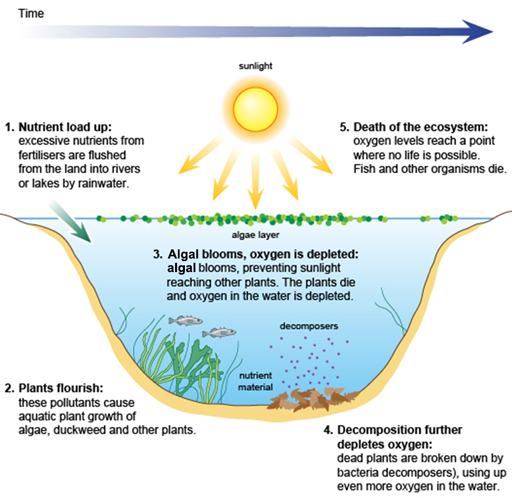Use 'Print preview' to check the number of pages and printer settings.
Print functionality varies between browsers.
Printable page generated Friday, 19 April 2024, 12:54 PM
Study Session 4 Water Pollution
Introduction
You have already learned about some of the ways how surface and groundwater can become contaminated and about the importance of water treatment to make the water safe to drink. There are different types of pollutants from a variety of sources that can harm the quality of water. In this study session you look more closely at these pollutants, where they originate from and their effects. You also consider how water sources can be protected from pollution.
Learning Outcomes for Study Session 4
When you have studied this session, you should be able to:
4.1 Define and use correctly all of the key words printed in bold. (SAQ 4.1)
4.2 Describe the different types of water pollutants. (SAQ 4.2)
4.3 Explain the possible ways in which water can be polluted. (SAQs 4.2 and 4.3)
4.4 Describe measures that can be adopted for protecting water sources from pollution. (SAQ 4.4)
4.1 Pathways of water pollution
Pollution can be defined as the introduction into the natural environment (air, water or land) of substances (pollutants) that are liable to cause harm to human health or to animals, plants and the wider environment. Water pollution occurs when surface water or groundwater is adversely affected by the addition of pollutants.
For surface water, the quality of the water will be determined by the geology, by precipitation and by what happens in the catchment. The catchment of a river is the total area of surrounding land that slopes towards the river (Figure 4.1). Rainwater that lands in a catchment flows into the river. River water can be contaminated from pollution sources in the catchment even though they may be some distance away. Protecting surface water from pollution is difficult because the activities of upstream users of river water will affect the quality of the water for downstream users. For groundwater, the situation is similar but the boundaries are less distinct and pollutants can seep into aquifers that extend below more than one catchment.
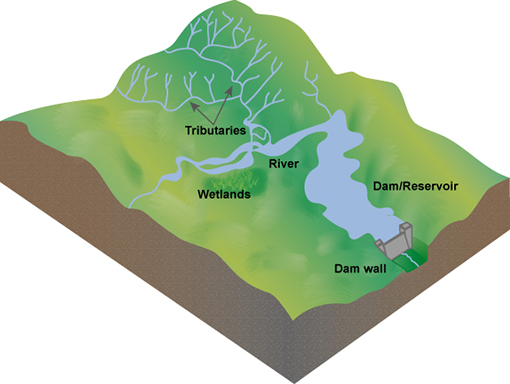
Water quality can be affected by pollution from point sources and non-point sources. Point sources are identifiable locations (such as a factory, often with a pipe or channel leading from them) that discharge directly into a body of surface water. Groundwater is also affected by point sources where contaminants seep into the soil and rock from an identifiable source, for example, underground fuel tanks, septic tanks or pit latrines. Non-point sources are those where pollution arises over a wide area and it is often difficult to locate the exact place of origin. For example, fertiliser or pesticide that has been widely spread may be washed from a field by rain into a river or stream at many places, or seep into groundwater. It is pollution from non-point sources, also known as diffuse pollution, that contributes most of the contaminants in surface and groundwater. The problems in identifying the exact point of origin make non-point sources much more difficult to control.
Look at Figure 4.2. What pollutants are likely to be washed into the river from the lorry? Is this a point source or non-point source of pollution?
Dust and dirt from the lorry will be washed into the river. Some oil and fuel may also be washed from the underside. The lorry is the single source of pollution, so this is an example of a point source.
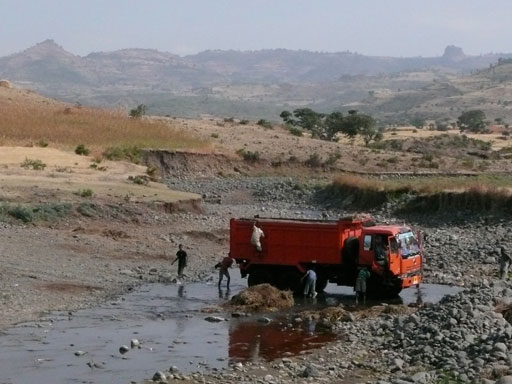
The normal flow of river water can reduce the impact of some pollutants. When contaminated river water moves downstream it is possible that any pollutant will be diluted as more water flows in and so increases the total volume of water in the river. This dilution may be enough to reduce the concentration of the contaminants sufficiently to minimise the possible impacts, but this depends on several factors, including the quantity and type of pollutant, and the volume and flow rate of the river.
4.2 Types of water pollutant
There are many different types of water pollutant and the following sections describe those that are most commonly found.
4.2.1 Sediments and suspended solids
Sediments and suspended solids consist of fine particles of mostly inorganic material. Inorganic material is derived from non-living sources and includes mud, sand and silt washed into a river as a result of land cultivation, construction, demolition and mining operations, where these take place. One of the most common sources of suspended solids and sediment is soil erosion, where the soil is washed away into rivers by rainwater run-off. The presence of solid particulate material suspended in the flowing water is the reason why many rivers look brown in colour, especially in the rainy season. The particles are called suspended solids while they are carried (suspended) in flowing water and sediments when they settle to the bottom. Large quantities of suspended solids may reduce light penetration into the water, which can affect the growth of plants. Sediments may even suffocate organisms on the river bed.
4.2.2 Organic matter
Organic matter, such as human and animal wastes, is derived from living organisms. As organic matter decomposes, it removes oxygen from the water and this can have a damaging effect on fish and other aquatic organisms that are sensitive to poor water quality. Box 4.1 explains this process. If a large quantity of organic matter is present in surface water, this can lead to anaerobic conditions. (Anaerobic means without oxygen, as opposed to aerobic, which means oxygen is present.) In this situation many aquatic organisms are unable to survive and the water will be stagnant and smell unpleasant.
Box 4.1 Oxygen in water
Many aquatic (water-living) organisms depend on oxygen dissolved in the water to survive. Aquatic animals include fish, amphibians and many invertebrate species such as insect larvae, snails and worms. Their supply of oxygen in the water is maintained from atmospheric oxygen in the air above the water and from oxygen produced by green aquatic plants by the process of photosynthesis, the process by which plants convert light energy into chemical energy, while taking in carbon dioxide from the atmosphere and producing oxygen. Fast-flowing, turbulent water will be aerated (gain oxygen) more than still water because the turbulent flow will entrain more oxygen.
If organic pollutants such as human and animal wastes are released into a water body, bacteria will use the waste as food and break it down into simpler, less harmful substances. As they do this, aerobic bacteria will use up the dissolved oxygen from the water. This is called deoxygenation. If the degree of organic pollution is high, then all the oxygen from the water may be used up, leading to anaerobic conditions.
This is unlikely in a river where the water is moving but can happen in lakes or slow-flowing channels. Inorganic solids, such as mud and silt, do not have this effect because they are inert (stable and inactive) and cannot be used as food by bacteria.
4.2.3 Biological pollutants
You have already learned about biological pollutants in Study Session 2. These are the infectious agents (bacteria, viruses, protozoa and helminths) that are harmful to humans and other forms of life. Biological pollutants may get into water with dust from the air as rain falls but the most likely source is from water that is contaminated with human and animal wastes.
4.2.4 Plant nutrients
Nitrates and phosphates are common pollutants generated from residential areas and agricultural run-off. They are usually associated with human and animal wastes or fertiliser that has been washed into surface water bodies by rain. Nitrates and phosphates are plant nutrients, so they stimulate plant growth. If present in large quantities, they can encourage excessive plant growth in the water causing the phenomenon known as an algal bloom, which means a sudden increase in the population of microscopic algae (simple plants). There may also be an increase in larger plants such as the invasive water hyacinth. When the increased population of aquatic plants dies, the decay of the organic plant material by bacteria can cause deoxygenation of the water, resulting in the death of other organisms such as fish. If a water body has high nutrient levels it is said to be eutrophic and the process is known as eutrophication. Figure 4.3 illustrates the process.
Can you think of a reason why eutrophication is more likely to be a problem in lakes than in rivers?
Because flowing water in a river will disperse the nutrients; in the still water of a lake, the nutrients will accumulate.
In Ethiopia, many private and corporate farms use huge amounts of chemical fertilisers. As a result, eutrophication is becoming a major problem (Zinabu et al., 2002), affecting many water sources (Figure 4.4).
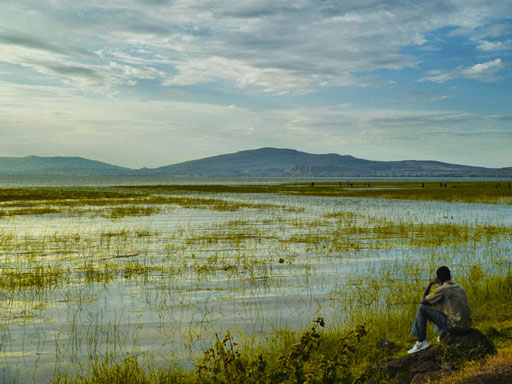
4.2.5 Other chemical pollutants
Heavy metals such as arsenic, copper, lead, mercury and cadmium are chemical pollutants that may be found in lakes, rivers and groundwater. These heavy metals can harm aquatic organisms and humans. Farmers who use river water polluted by urban wastes for irrigation in the cultivation of fruits and vegetables may find their crops affected by the accumulation of these chemicals. (You will look at a case study on this later on in this study session.)
Pesticides include insecticides, herbicides and fungicides. There are several thousand different types in use and almost all of them are possible causes of water pollution. Pesticides such as DDT (dichlorodiphenyltrichloroethane), malathion, parathion and others have been sprayed in the environment for long periods of time for the control of disease vectors such as mosquitoes and other pests.
Heavy metals and some pesticides are particular problems because they are persistent in the environment, meaning they do not break down and their effects continue over time, even long after their use may have stopped.
Another problem can be acidity. If water becomes acidic or alkaline, beyond normal limits, this will have a damaging effect on aquatic organisms. Acidity and alkalinity of water are determined by measuring its pH. A pH value below 7 is acidic and above 7 is alkaline. Acidic water is not only harmful to life but is also corrosive and can damage pipework in water distribution systems.
4.3 Possible sources of water pollution
Having looked at the various types of pollutant, let us now consider their sources.
4.3.1 Human excreta
Open defecation and poorly constructed pit latrines are obvious sources of human waste and can easily pollute surface and groundwater. Where water-flushed sewerage systems are present, inadequately treated sewage can also be a major source of human waste. (Note the difference between the words ‘sewage’ and ‘sewerage’. Sewage is mixed wastewater that contains human waste from flush toilets, commercial and industrial wastewater, and frequently also surface water run-off. Sewerage is the network of underground pipes – sewers – through which the sewage flows.)
Untreated or partially treated sewage can contribute to high levels of oxygen demand in the water and also introduce toxic substances into the aquatic environment, in addition to pathogenic micro-organisms. In Ethiopia, sewage may be treated in waste stabilisation ponds (these will be described in Study Session 11). If not operated properly, these ponds can pollute rivers. In many parts of the world, sewage from large towns and cities is usually treated in large mechanical–biological plants (Figure 4.5) that normally produce good quality effluent but can still be a source of pollution if systems fail.
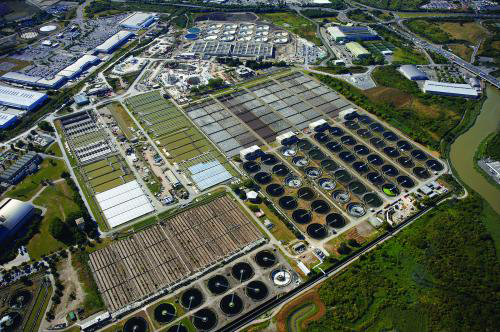
In Ethiopian towns and cities many households use septic tanks to dispose of their sewage. These are underground tanks into which sewage is piped. The waste remains in the tank for long enough for the solids to settle out and the settled sewage is discharged from the tank, usually into the surrounding soil via a soakaway. If the tank is too small to retain the sewage for long enough, or if many septic tanks are close together, or if they leak or are cracked, this can lead to pollution of groundwater. It is the aim in Ethiopia to have septic tanks that keep the sewage inside for a minimum of three days so that the organic solids will settle out as sludge. Figure 4.6 shows the main features of a properly constructed septic tank.
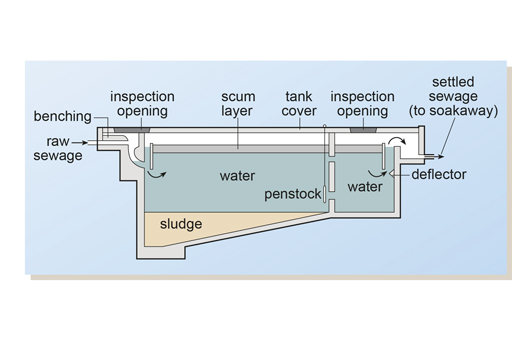
4.3.2 Manufacturing and industrial plants
In Study Session 1 you read about some of the ways in which water is used in industry and manufacturing. The range of different uses and processes can produce waste in the form of many different types of organic and inorganic material in suspension or in solution. In many cases, much of the water used can be recycled but there is almost always an effluent discharge that requires treatment.
Food processing generates large volumes of effluent containing natural organic compounds such as carbohydrates, proteins and fats. Factories producing chemicals often generate low volumes of highly toxic waste streams. Toxic effluents can also be produced in the paper, leather and electroplating industries. For example, cyanides and heavy metals may be present in wastewaters from electroplating. These plants can also be the source of highly acidic wastes.
Manufacturing and industrial effluents should be treated at their points of origin but many production plants in Ethiopia (such as tanneries and breweries) do not have proper effluent treatment systems. This results in the discharge of untreated or partially treated effluent into the nearest water body (Figure 4.7).
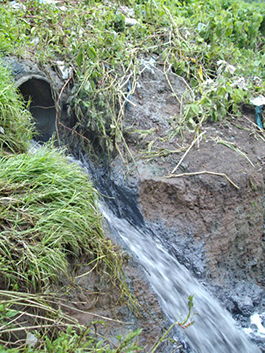
4.3.3 Agriculture and animal rearing
The intensive rearing of animals results in large volumes of organically polluted washwater from cleaning animal houses. This slurry is often stored in lagoons or tanks prior to spreading on land. However, problems occur when these lagoons or tanks leak or overflow, allowing the slurry to flow into watercourses or infiltrate groundwater. Other agricultural pollutants include pesticides and fertilisers.
Cultivation and overgrazing can make soil erosion more likely, resulting in soil particles being washed into rivers and lakes. For example, this is a problem at Gondar, where run-off from the surrounding land has washed silt into the reservoir, thus reducing the volume of water it can hold (Figure 4.8).
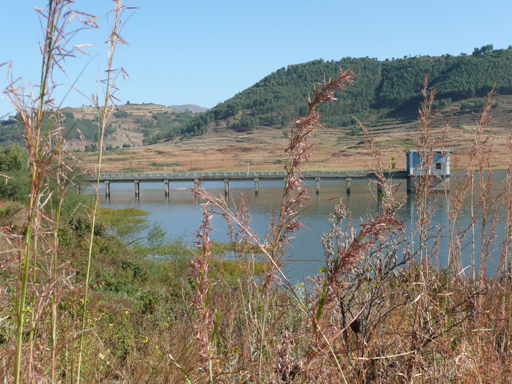
4.3.4 Domestic and industrial solid waste sites
Domestic and commercial solid waste should be disposed of in a properly designed and constructed landfill site. Many landfill sites, particularly those that are older and less well designed and managed, such as the one shown in Figure 4.9, generate leachate, which is highly polluting. (Leachate is any liquid that has passed through matter and picked up dissolved substances and/or suspended solids as it passed through.) Leachate can contain dissolved organic matter and many different types of inorganic components depending on the type of waste. Where industrial waste has been dumped, a toxic chemical stream may also be produced. These leachates should be collected and treated so that pollution of groundwater and rivers does not arise.
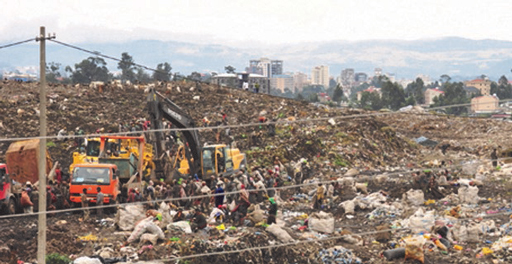
4.3.5 Urban surface water run-off
Rainwater that runs off road surfaces, roofs, parking areas, etc. carries with it a variety of components (Table 4.1). The bulk of the contaminants can be traced to motor vehicles. Surface water run-off can cause damage to streams, rivers and lakes by degrading the water quality and harming aquatic life. The pollutants present can hinder the growth and reproduction of fish and other creatures, and affect photosynthetic activity. Plant nutrients may contribute to eutrophication.
| Pollutant | Likely sources |
| Sediment | Construction, road surfaces, emissions from vehicles, industrial sources, vehicle wear |
| Copper | Vehicle brake pads, industrial activities, plumbing and guttering |
| Lead | Industrial activities and residues from historical activities (plumbing, paint, leaded petrol, sprays), tyre-balancing weights, vehicle brake pads |
| Zinc | Vehicle tyres, galvanised building materials, paint, industrial activities |
| Hydrocarbons | Vehicle emissions, lubricating oils |
| Rubber | Tyre wear |
| Detergents | Wash-down areas, domestic discharges (e.g. from car washing), industrial discharges |
| Litter | Discarded material (e.g. plastic bags, cups, cigarette ends), windblown materials, illegal dumping |
4.4 Protection from pollution
The control of pollution should ideally take place at the point of its generation. In Study Session 3 you read about the methods of protecting water sources but it is better to prevent the pollutant from entering the environment in the first place. With regard to human excreta, this means an end to open defecation, the correct siting and construction of latrines and septic tanks, and well-maintained and correctly operated sewage treatment works. Industrial wastes should be treated at source before discharge. Other human activities should also be controlled; for example, used engine oil should not be thrown onto the ground, and solid wastes should be carefully disposed of. A positive measure that can help to prevent soil erosion is to preserve vegetation and plant trees, because plant roots hold the soil in place.
In rural areas, the control of excess nutrients is important to keep natural waters free from eutrophication. Farmers may need guidance on good agricultural practices to reduce water pollution from agriculture. For example, care over the amount of fertiliser used and the timing of its application can make a significant difference.
Imagine you are a farmer thinking about the best time to apply fertiliser to your field. Would it be better to spread the fertiliser before or after heavy rain?
It would be better to apply it after the rain because if the fertiliser was spread beforehand, much of it would probably be washed away. This would not only pollute the nearest river but would, of course, also reduce its effectiveness on the crop.
Pesticides should not be applied near wells or other water sources. If possible, biological methods of pest control should be used. Examples of these are the use of fish to feed on mosquito larvae in water bodies, and the use of the dung beetle to break down and bury cow faeces so that they are no longer available as a breeding place for flies.
Ideally, the whole catchment area should be managed to avoid pollution and erosion. To tackle pollution problems, especially diffuse pollution, all activities within a catchment should be considered. This involves many groups (residents, planners, farmers, etc.) working together, on aspects such as granting permissions for development, compliance with regulations, inspections of activities, and regular surveys and investigations of water pollution.
4.5 Monitoring and regulation
Monitoring of the quality of rivers (Figure 4.10) can be done at regular intervals by taking samples for laboratory analysis. In Ethiopia this activity is undertaken by the Ministry of the Environment and Forests. In addition to this, regular surveys of a catchment area are useful so that potential pollutants can be identified before they contaminate a water source.
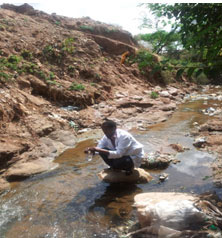
For effective protection of water sources, it is important to establish a regulatory framework for treatment of wastewater from residential communities, institutions and industries. Strict legislation should be in place to make it obligatory for wastewaters to be treated before discharge into rivers or lakes. Ethiopia has the Ethiopian Water Resources Management Regulations (Council of Ministers, 2005). Part 4 of these regulations states that a permit to discharge wastewater must be obtained for the ‘direct or indirect discharge of any treated trade effluent or sewage effluent, or any poisonous, noxious or polluting matter into surface or ground water’. Anyone who obtains the permit has an obligation to install and use the best treatment method and to discharge only the type and volume of treated waste permitted.
Control of water pollution is the responsibility of more than one organisation, since most activities involving water concern a number of different Ministries. For instance, water use in agriculture would be of concern to the Ministry of Agriculture, the Ministry of Water Resources, Irrigation and Energy, and the Ministry of the Environment and Forests, and all of them have the responsibility of protecting the environment.
Summary of Study Session 4
In Study Session 4, you have learned that:
- Water pollution is any contamination of water with substances that are detrimental to human, plant or animal health.
- Water pollutants can be of point or non-point source, depending on whether substances are discharged directly into a body of water or indirectly from diffuse sources.
- Water pollutants include sediments and suspended solids, organic matter, biological pollutants, plant nutrients and chemical pollutants.
- Biological pollutants include bacteria, viruses, protozoa and helminths. They mainly enter the water through faeces from infected people and animals, and are the cause of many water-related diseases.
- Major sources of water pollution include human excreta; manufacturing and industrial plants; animal rearing and agricultural activities; landfill sites; and urban surface water run-off.
- Measures to protect water sources from faecal pollution include ending open defecation, the proper siting of latrines and septic tanks, and careful operation of sewage treatment works.
- The appropriate use of fertilisers and pesticides will minimise water pollution caused by agriculture.
- Selective planting of trees and vegetation can help stabilise soil and prevent erosion.
- Pollution control should ideally take place at the point of origin.
- Regulations control the type and volume of treated effluent that may be discharged to the environment.
Self-Assessment Questions (SAQs) for Study Session 4
Now that you have completed this study session, you can assess how well you have achieved its Learning Outcomes by answering these questions.
SAQ 4.1 (tests Learning Outcome 4.1)
Match the following words to their correct definitions.
Using the following two lists, match each numbered item with the correct letter.
eutrophication
aerobic
organic matter
septic tank
point-source of pollution
soil erosion
inorganic material
sewerage
algal bloom
non-point source of pollution
suspended solids
pollution
pollutants
sewage
diffuse pollution
catchment
sediments
leachate
anaerobic
photosynthesis
a.a polluting liquid that is produced when water passes through materials and takes with it components from them
b.the introduction into the environment of substances likely to cause harm to humans, animals, plants and the environment in general
c.substances that can cause harm to human health, plants, animals and the environment in general
d.material that comes from living organisms
e.a process by which a high concentration of nutrients, especially phosphates and nitrates from agricultural or other activities, enters a water body and lead to excessive plant growth and eventual decay, resulting in depletion of oxygen in the water
f.the process by which plants generate chemical energy
g.the area of surrounding land that slopes towards a river
h.an identifiable source of pollution
i.solids that have settled at the bottom of a river
j.a network of sewers
k.without oxygen
l.pollution from non-point sources
m.particles carried in flowing water
n.material which does not originate from living organisms
o.mixed wastewater that contains human waste from flush toilets
p.an underground tank into which sewage is piped
q.containing oxygen
r.a sudden increase in the algal population
s.a source of pollution that encompasses a wide area, the exact point of origin being difficult to ascertain
t.the washing away of soil by rainwater run-off
- 1 = e
- 2 = q
- 3 = d
- 4 = p
- 5 = h
- 6 = t
- 7 = n
- 8 = j
- 9 = r
- 10 = s
- 11 = m
- 12 = b
- 13 = c
- 14 = o
- 15 = l
- 16 = g
- 17 = i
- 18 = a
- 19 = k
- 20 = f
SAQ 4.2a (tests Learning Outcome 4.2)
Classify the following examples of water pollutants using the categories shown in the table below:
- copper
- insecticides
- sand
- protozoa
- nitrates
- bacteria
- lead
- silt
- phosphates
- faecal matter
- intestinal worms
| Category of water pollutant | Examples |
| Sediments and suspended solids | |
| Organic matter | |
| Biological pollutants | |
| Plant nutrients | |
| Other chemical pollutants |
Answer
The answer is as follows:
| Category of water pollutant | Examples |
| Sediments and suspended solids | sand, silt |
| Organic matter | faecal matter |
| Biological pollutants | bacteria, protozoa, intestinal worms |
| Plant nutrients | nitrates, phosphates |
| Other chemical pollutants | copper, lead, insecticides |
SAQ 4.2b (tests Learning Outcome 4.2)
The following are pollution sources. Give two specific pollutants for each source.
A residential area: ………………………………………………
A metal plating plant: ………………………………………………
Agricultural activities: ………………………………………………
An uncontrolled landfill site: ………………………………………………
Urban surface water run-off: ………………………………………………
Answer
There are several possibilities, listed below.
| A residential area: | human excreta, wastewater containing dissolved and suspended organic matter, suspended inorganic matter, pathogenic micro-organisms |
| A metal plating plant: | cyanides, heavy metals |
| Agricultural activities: | nitrates, phosphates, pesticides |
| An uncontrolled landfill site: | leachate containing dissolved organic matter, inorganic components and heavy metals |
| Urban surface water run-off: | sediment, metals, hydrocarbons, rubber, detergents, litter |
SAQ 4.3 (tests Learning Outcomes 4.2 and 4.3)
Read Case Study 4.1 and then answer the questions that follow.
Case Study 4.1
Mekanisa is a place in the southern part of Addis Ababa where urban agriculture is practised. A group of farmers grow different varieties of vegetables and sell them to people in the city. The farmers use water from the nearest river (the River Kera) for irrigation. They mostly grow leafy vegetables, with two harvests a year.
The Kera River originates a few kilometres from Mekanisa and passes through residential, commercial and industrial areas before reaching Mekanisa. Along its way, human excreta and industrial wastes are indiscriminately discharged into the river. One of the prominent polluters of the river is the city’s biggest slaughterhouse, located at the side of the river. Untreated wastewater from the slaughterhouse is discharged into the river giving a blue-black colour to the water. Farmers like this type of water for irrigation as it helps their crops grow.
One of the authors of this Module undertook research assessing the level of pollution of the river water. The results are shown in Table 4.2.
| Parameters | FAO* Guideline Concentrations for components in irrigation water (Pescod, 1992) | River water |
| Faecal coliforms | >2500 per 100 ml | |
| Copper | 0.2 mg l-1 | 25.5 mg l–1 |
| Zinc | 2.0 mg l-1 | 56.3 mg l–1 |
| Iron | 5.0 mg l-1 | 71.0 mg l–1 |
| Lead | 5.0 mg l-1 | 19.0 mg l–1 |
| Manganese | 0.2 mg l-1 | 37.0 mg l–1 |
| *FAO is the Food and Agriculture Organization of the United Nations. | ||
- a.What nutrients in the river water do you think benefited the crops grown by the farmers?
- b.State which components in the river water might be harmful to people and give your reasons.
- c.Suggest what should be done regarding the pollution of the River Kera.
Answer
- a.There are likely to be nitrates and phosphates in the river water which are vital to plant growth.
- b.The presence of a high number of faecal coliformsindicates that the water is unsafe, and also that other micro-organisms, which may be pathogenic, may be present. The concentrations of copper, zinc, iron, lead and manganese in the river water are all greater than the guideline values recommended by the FAO. This implies that they are harmful.
- c.Pollution control at source is required. This would entail treating the sewage, industrial effluents and slaughterhouse wastewaters before they are discharged into the river.
SAQ 4.4 (tests Learning Outcome 4.3)
Which of the following statements is false? In each case, explain why it is incorrect.
- A.Latrines should be sited up-slope of a water source so that they don’t get flooded.
- B.For the protection of springs, a fence, a diversion ditch, a watertight concrete box, and a tight-fitting cover are enough.
- C.Farmers should use the minimum amount of fertiliser that is necessary for their crops, and apply it after rain.
- D.Catchment management involves several different activities to ensure that the integrity of a water source is maintained.
- E.To save time water pollution control legislation is best drawn up by one ministry.
Answer
A is false. Latrines should be below a water source on sloping ground otherwise seepage from the pit could flow down into the water source.
B is false. The protection measures are correct but the cover should have a lock.
E is false. Water use is relevant to several different ministries, all of which should be consulted when legislation is being prepared.
